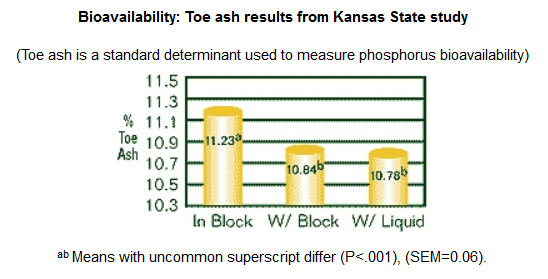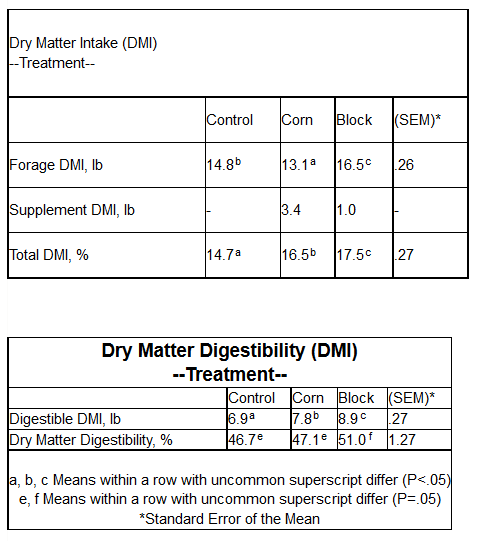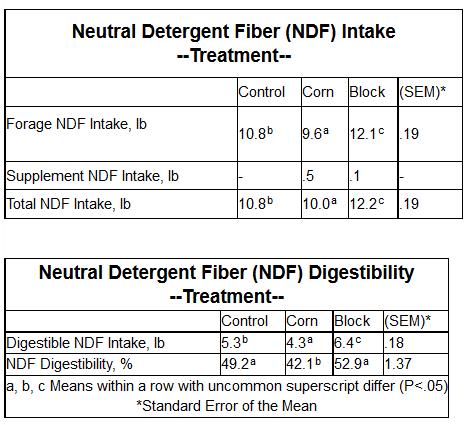In recent years, low-moisture block livestock supplements have steadily grown in popularity among cow-calf producers as an effective method of providing their cattle with supplemental protein, energy and other essential nutrients with minimum labor input. In support of producer testimonials, recent research studies have been completed which demonstrate important nutritional benefits provided by low-moisture blocks. These blocks are typically licked from a steel container
One study was conducted at the University of Florida and two studies were conducted at Kansas State University.
These studies evaluated CRYSTALYX®. Overall, the studies provide data which indicate increased bioavailability of phosphorus, and proof that molasses blocks such as CRYSTALYX® Brand Supplements enhance digestibility and intake of lower quality forages.
Mark Robbins, Research and Formulations Coordinator for Ridley Block Operations, was pleased with the results of the research work at Florida and Kansas State.
"The benefits shown by these studies – increased bioavailability of phosphorus and improved intake and digestibility of low quality forages are important for maintenance, growth and acceptable reproductive performance of beef cows," said Robbins. "Now we've been able to measure and quantify these benefits provided by low-moisture block supplements."
Bioavailability of Phosphorus in Low-Moisture Block Supplements
Initial research done at the University of Florida showed an increase in phosphorus bioavailability with low-moisture block supplements. After receiving the results from this trial, researchers began to ask the same question cattle producers and nutritionists might ask. Was the response due to the molasses used in the low-moisture block, the cooking process or the added phosphorus in a cooked block?
Subsequent research by Dr. R. Scott Beyer of Kansas State University identified what factors were instrumental in achieving the increased phosphorus bioavailability. Using a standardized chick toe ash study, Dr. Beyer tested for effects due to the source of molasses in the block using concentrated separator by-product (CSB), cane molasses and beet molasses. In addition, the trial tested corn-soy diets containing supplemental phosphorus (dicalcium phosphate) from four different sources: 1) as is from the bag, 2) in the block, 3) as is with the block, and, 4) as is with the liquid form of molasses. The trial had 40 treatments; each treatment was replicated with eight pens. The experiment had two, 21-day periods of four replications each, requiring a total of 3,200 broiler chicks. Toe ash is a standard determinant used to measure phosphorus bioavailability.
According to Dr. Beyer's research, the increase in phosphorus bioavailability observed in the Florida trial was due to adding supplemental phosphorus to a cooked block. A cooked block without supplemental phosphorus and/or the liquid form of the molasses did not increase the bioavailability of supplemental phosphorus. Similar responses were observed in CSB, cane and beet molasses blocks. In other words, the unique cooking process used to produce low-moisture block supplements appears to increase supplemental phosphorus bioavailability, regardless of the molasses source.

The Effects of Supplement on Intake and Digestion of Prairie Hay By Steers
Another research study involving low-moisture block supplements was recently conducted by Dr. Evan Titgemeyer at Kansas State University. The objective of this trial was to determine the effect of different supplementation strategies on intake and digestion of lower quality prairie hay (Crude Protein = 5.7%, Neutral Detergent Fiber = 72%) by steers. Because forage digestion and intake influence available energy for maintenance, growth and reproduction, producers often supplement lower quality forages with grains or protein concentrates.Results of this trial indicate that the block treatment increased digestible dry matter intake 29% compared to the control, and 14% compared to the shelled corn treatment. Furthermore, the block treatment had the highest (P=.05) dry matter digestibility with the highest (P<.05) dry matter intake.


"This is a classic example of the negative associative effect of highly fermentable starch on fiber digestion," notes Robbins. "With a low-moisture block supplement, we can increase digestible fiber intake without the negative effects of the starch found in grain."
Bob Frost, General Manager of Ridley Block Operations is not surprised by the recent research findings from the University of Florida and Kansas State University.
"These trials really confirm what cattle producers have been experiencing in the field," says Frost." Low-moisture blocks provide important nutritional benefits over conventional supplements."
Depending on the product selected, low-moisture block supplements can be fed for approximately 10¢ to 25¢ per-head, per-day, according to Frost.
"When you consider the labor-saving convenience, along with the nutritional benefits, it's easy to see why a growing number of cattle producers are feeding low-moisture block supplements," he said.


